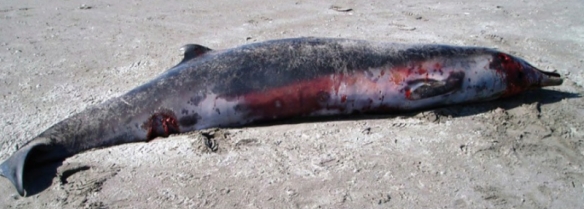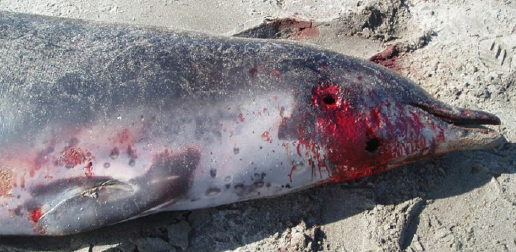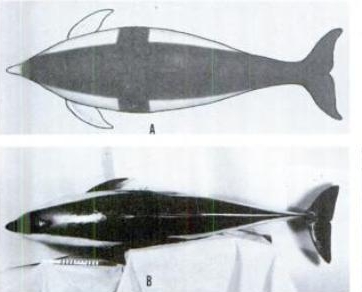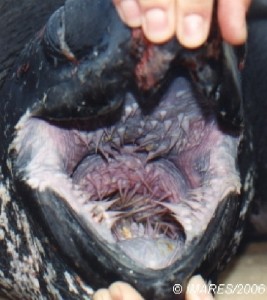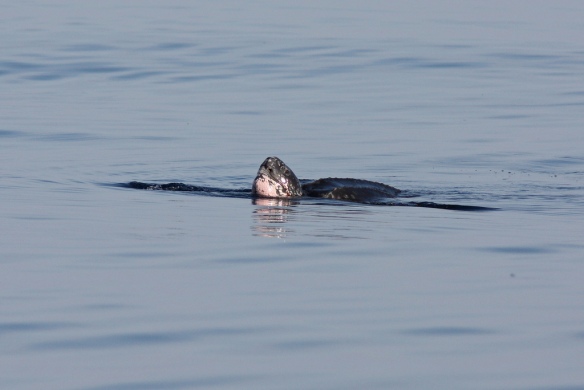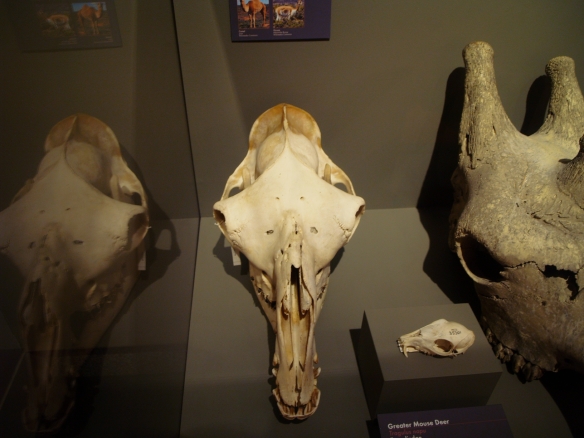I am now writing at The Lord Geekington (WordPress) and Biological Marginalia (tumblr). I really need to stop doing this.
The Spade-Toothed Whale
It is almost beyond belief that in the 21st Century there was a whale so obscure it was known only from three partial skulls. But no more, the Spade-Toothed Whale (Mesoplodon traversii) has finally turned up in the flesh:
For such a reticent species, the Spade-Toothed Whale has a surprisingly long history. The first known remains consisted of a mandible washed up on the Chatham Islands discovered by a Henry H. Travers (Esq.) in 1872 (van Helden 2002). Hector (1873) classified the mandible as ‘Dolichodon layardii‘, now known as Mesoplodon layardii, the Strap-Toothed Whale. Gray (1874) argued that the Chatham Islands specimen was sufficiently different to warrant status as a distinct species, ‘Dolichodon‘ traversii. While the species are superficially similar in having large teeth with a denticle at the apex, M. layardii specimens consistently have tapering strap-like teeth whereas the M. traversii specimen has shorter, whaler’s spade-shaped teeth with a prominent denticle (van Helden 2002). Hector (1878), without explaining why, stood by his original classification, and for over a century the significance of the jaw from the Chatham Islands went unrecognized.
In 1986, a damaged calvaria (skull sans mandible) was discovered on Robinson Crusoe Island and, despite lacking the typically diagnostic teeth, it was considered distinctive enough to be classified as a new species, Mesoplodon bahamondi (Reyes et al. 1996). Baker (2001) discovered that another calvaria collected in the 1950’s from Whakaari, New Zealand previously thought to be M. ginkgodens was in fact a second specimen of Bahamonde’s Beaked Whale. Analysis of mtDNA revealed that the calvariae were indeed from the same species… as was the mandible from the Chatham Islands (van Helden et al. 2002). Thus a complete picture of the Spade-Toothed Whale’s skull was revealed, but every other aspect of the species’ biology remained a tantalizing blank. It’s a little less blank now.
In December 2010, a female and male calf stranded on Opape Beach, New Zealand and after being initially identified as Mesoplodon grayi, mtDNA revealed they were in fact M. traversii (Thompson et al. 2012). The confusion with M. grayi appears to have resulted from similar mouth-lines, dorsal fin and flipper shape but it is distinctive in having a more prominent melon, and dark rather than white rostrum (Thompson 2012). Thompson (2012) mentions a dark eye patch, white belly, and dark flippers as “notable”, but it appears female M. grayi arguably exhibit these traits as well.
Reyes et al. (1996) estimated that the Robinson Crusoe Island calvaria belonged to a 5.0-5.5 meter whale, and it is curious that the stranded female was close to the midpoint at 5.3 meters long (Thompson et al. 2012). If the Spade-Toothed Whale exceeds 5 meters on average, it would be among the largest mesoplodonts, second only to the Strap-Toothed Whale (MacLeod 2005). Since the two species appear to be similar in size and tooth morphology, it could be possible they occupy a similar niche and avoid competition with spatiotemporal segregation, similar to the North Atlantic ziphiids (MacLeod 2005).
And for even more rampant speculation – has Mesoplodon traversii been seen before? In 1980 and 1983 Bob Pitman observed unknown cetaceans in the East Pacific with extremely long and narrow rostrums, strait gapes, a white mandible contrasting with a dark gray rostrum, and a light patch behind the eyes present in both an apparent mother and calf (Pitman & Lynn 2001). Pitman & Lynn (2001) notably speculated that it may be M. bahamondi, suggesting the ~30 degrees of latitude from Robinson Crusoe Island is not necessarily hugely problematic. Looking at the above photograph of the stranded female, I could see how the described coloration fits, but confusingly the reconstruction in Thompson et al. (2012) has a white area somewhat ahead of the eyes and the beak is entirely dark. Post-mortem color interpretation in whales is notoriously tricky to interpret, and it will probably take photographs of live specimens under clear lighting to document all the subtle aspects of the coloration. While the beak of M. traversii is long, those of female M. grayi are ridiculously so, so this is also problematic. Additionally, the juvenile M. traversii had a “color pattern characteristic of most juvenile mesoplodont beaked whales” (Thompson et al. 2012), apparently meaning it did not have the same coloration as the female. ‘Mesoplodon species B.’ remains an enigma, but I wouldn’t bet against regional M. traversii color variants.
Have I mentioned that this is the marine biological discovery of the century?
References:
Baker, A. (2001) Status, relationships, and distribution of Mesoplodon bowdoini Andrews, 1908. Marine Mammal Science 17, 473-493. DOI: 10.1111/j.1748-7692.2001.tb00999.x
Hector, J. (1873) On the Whales and Dolphins of the New Zealand Seas. Transactions of the New Zealand Institute 5, 154-170. Available.
Hector, J. (1878) Notes on the Whales of the New Zealand Seas. Transactions of the New Zealand Institute 10, 331-343. Available.
MacLeod, C. (2005) Niche Partitioning, Distribution And Competition In North Atlantic Beaked Whales. Doctor of Philosophy Thesis at University of Aberdeen. Available.
Pitman R. & Lynn, M. (2001) Biological observations of an unidentified mesoplodont whale in the eastern tropical Pacific and probable identity: Mesoplodon peruvianus. Marine Mammal Science 17, 648-657. Available.
Reyes, J. C., et al. (1996) Mesoplodon bahamondi sp. n. (Cetacea, Ziphiidae), a new living beaked whale from the Juan Fernández Archipelago, Chile. Boletin del Museo Nacional de Historia Natural, Chile 45, 31-44. Available.
Thompson, K., et al. (2012) The world’s rarest whale. Current Biology 22(1). Available. Supplement.
van Beneden, P.-J. & Gervais, P. (1880) Ostéographie des Cétacés, vivants et fossiles. Available.
van Helden, A., et al. (2002) Resurrection of Mesoplodon traversii (Gray, 1874), senior synonym of M. bahamondi Reyes, van Waerebeek, Cárdenas and Yáñez, 1995 (Cetacea: Ziphiidae). Marine Mammal Science 18(3), 609-621. Available.
The Cryptic Berardius
It is sometimes claimed the two species of Giant Beaked Whale (Berardius bairdii, B. arnuxii) are practically identical, and may thus be disjunct populations rather than distinct species (e.g. Reeves et al. 2002, Wikipedia). This seems increasingly unlikely to be true. The species were estimated to have diverged 0.68-5.81 million years ago, which probably makes them younger than the similarly anti-tropical Hyperoodon species (2.37–11.53 mya), but likely older than other cetacean pairs universally considered distinct (Lissodelphis borealis/L. peronii, Globicephala macrorhynchus/G. melas, etc) (McGowen et al. 2009). Morphologically, the Berardius species differ in flipper size and in the shape of the nasal bones and vomer (Kasuya 2009); the Beaked Whale Identification Guide states that literature describing cranial differences is not yet available, so this list is probably incomplete.
Berardius bairdii is far from uniform itself, as Japanese populations from the Pacific Ocean, Sea of Japan and Sea of Okhotsk reportedly differ morphologically (Kitamura et al. 2012 – citing Kishiro 2007). How, or whether, these purported populations differ genetically has yet to be determined. There is a fourth Japanese population, however, which is unambiguously distinct. In the Sea of Okhotsk (off Hokkaido) slate-gray specimens observed year-round appear to be vanilla B. bairdii, but there are also black individuals present from April to June (Kitamura et al. 2012). These individuals are quite rare, with Kitamura et al. only managing to acquire three in archives. The only specimen with a determined length measured 6.6 meters yet remarkably, it was mature (Kitamura et al. 2012). Comparatively, B. bairdii is believed to first ovulate at 9.8-10.7 m (Kasuya 2009). To put how small 6.6 meters is (for a B. bairdii) in perspective, of the 64 ‘normal’ specimens Kitamura et al. examined, only three were smaller than 6.6 m (5, 4.2, 1.8 m) and they were likely a pre-weaned juvenile (Huang et al. 2009), a newborn (Kasuya 2009) and a fetus, respectively.
Small size on its own is of course not proof of divergence – particularly when only one individual was measured – so that’s where DNA comes in. Nuclear DNA weakly distinguished the black specimens, however mtDNA had high bootstrap values and placed them outside the B. bairdii–B. arnuxii clade. Kitamura et al. suggested that the black Berardius individuals could very well be a cryptic species, although their study was too preliminary to formally describe it. There still remains a lot of genetic and morphological work to sort out just what’s happening with the Berardius variants and maybe some day we’ll see a third species added to the field guides.

A parsimony network of mtDNA CR sequences taken and modified from Kitamura et al. (2012). The circle size indicates abundance, and the small unlabeled circles indicate intermediate or missing haplotypes.
As beaked whales gradually become less mysterious, it seems likely additional cryptic subspecies or even species will be described. This is, of course, a story for another day
References:
Huang, S-L. et al. (2009) Comparable length at weaning in cetaceans. Marine Mammal Science. Available.
Kasuya, T. (2009) Giant Beaked Whales IN: Perrin, W. et al. (eds.) Encyclopedia of Marine Mammals.
Kishiro, T. (2007) Geographical variations in the external body proportions of Baird’s
beaked whales (Berardius bairdii) off Japan. Journal of Cetacean Research and
Management 9, 89–93.
Kitamura, S. et al. (2012) Two genetically distinct stocks in Baird’s beaked whale (Cetacea: Ziphiidae) Marine Mammal Science doi: 10.1111/j.1748-7692.2012.00607.x
McGowen, M. et al. (2009) Divergence date estimation and a comprehensive molecular tree of extant cetaceans. Molecular Phylogenetics and Evolution 53, 891–906. Available.
Reeves, R. et al. (2002) National Audubon Society Guide to Marine Mammals of the World.
Gosse’s Delphinorhynchus
Late in his career, Philip Henry Gosse became convinced that ‘sea-serpents’ reported by proper English eyewitnesses were plesiosaurs. Gosse (1861) argued that a total lack of remains was not necessarily problematic since two cetaceans were also known only from sightings: ‘delphinus rhinoceros‘ and a ‘Delphinorhynchus‘ with “remarkable” white flippers which Gosse happened to observe. The later ‘sea-serpent’ researcher Bernard Heuvelmans (1968) picked up on Gosse’s account and interpreted it as an undescribed species of (probable) beaked whale, a notion which still shows up in cryptozoology books and websites. It’s a shame this purported ‘cryptid’ has never been critically assessed – so far as I can tell – since beaked whales have a long history of being difficult to detect. Gosse’s sighting, however, is also quite problematic and it can probably never be determined just what he saw. That won’t stop me from discussing it, of course.
Gosse (1851) observed that one of his mystery cetaceans had a head “exactly” like that of ‘Delphinorhynchus‘, with no furrow between the “forehead” and snout being visible. As for what ‘Delphinorhynchus‘ meant to Gosse, his account describes two species in the now-invalid genus: ‘D. micropterus‘ (“The Toothless Whale of Havre”) and ‘D. rostratus‘. The former is a synonym of the beaked whale Mesoplodon bidens whereas the latter appears to be Gosse’s unique name for the Rough-Toothed Dolphin, Steno bredanensis. These distantly related species have superficially similar heads due to a flat melon and medium-long beak, so Gosse’s cetacean probably had these traits as well. Gosse (1856) was familiar with other ziphiids (‘Hyperoodon bidentatus‘, ‘Diodon sowerbyi‘) but considered them distinct due to their battle teeth; curiously, the latter species is in fact another synonym for M. bidens. Gosse’s understanding of ziphiids was incredibly crude by modern standards, but the description of the head coupled with that of the body (elongated, small dorsal fin set far back) makes it seem likely his mystery cetaceans were beaked whales, and mesoplodonts at that.

‘Delphinorhynchus micropterus’ (top) and ‘Diodon sowerbyi’ from Gosse (1856). Is it me, or has the top one been _Steno_-ized?
Behaviorally, Gosse’s cetaceans could not have been less cryptic. They traveled in a “herd”, “trooping towards the ship” and then stayed with it for around 17 hours and 120 English miles (~190 km). Gosse (1851) made no mention of extended disappearances (due to diving) but did observe the cetaceans “romp and frolic, in the manner of Dolphins”, protrude their heads above the surface, swim on their backs and (as reported by an officer) even breach. The behavior Gosse observed was undoubtedly extreme, but has some precedence in ziphiids: Hyperoodon approaches boats more frequently than other ziphiids (enough so to result in heavy hunting) (Dalebout et al. 2006); large groups of Indopacetus have been noted to be very active at the surface and to approach ships (Anderson et al. 2006); encounter durations in one study of Hawaiian M. densirostris and Ziphius averaged 1.45 hours, with one lasting 8.3 h (McSweeney et al. 2007); another study of M. densirostris found a wide range of reactions to vessels (avoidance, keeping distance, approach) and while surface behavior was usually inconspicuous, tail-slaps, head-raises, porpoising, and even a breach were observed (Ritter and Brederlau 1999). I can’t find any observations of ziphiid diving behavior (apparently) being disrupted for so long, but still, stranger reactions to human presence has been observed – one group of Pseudorca reportedly following a ship from Brazil to the English Channel (Tomilin 1967), for instance.
Gosse’s sighting occurred at 19°1′ N., 45°42′ W. – the middle of the North Atlantic – which is within the ranges of Mesoplodon densirostris, M. europaeus and Ziphius; Hyperoodon ampullatus, M. bidens and M. mirus are other North Atlantic ziphiids which have been recorded within 10 degrees of latitude of the sighting (MacLeod et al. 2006). Before throwing around the label of ‘cryptid’, it’s critically important to at least review these species and how well they fit Gosse’s descriptions.
The ‘Delphinorhynchus‘ comparison strongly fits with M. bidens and M. europaeus, albeit only if Gosse overlooked the battle teeth in males or observed a group composed only of females and immature individuals. Female M. densirostris may fit, despite the arched jawline, but males are utterly unmistakable. M. mirus is iffy since for a mesoplodont it has a rounded melon and short beak. Ziphius, whose external appearance Gosse was probably unfamiliar with, has a very short beak and melon more pronounced than any mesoplodont, and is thus an unlikely candidate. Gosse (1856) demonstrated he was familiar with Hyperoodon.
Gosse estimated his cetaceans to be about 30 feet (~9.1 meters) in length (“or perhaps not quite so much”), a size only Berardius bairdii regularly exceeds (MacLeod 2005). H. ampullatus may reach 10 m, but is on average much smaller, with a median length of 6.4 m and modes of 6.1-6.2 and 6.4–6.5 m (MacLeod 2005); surprisingly, it really isn’t much longer than the mesoplodonts on average*. Cryptozoologists have a bad habit of interpreting size estimates literally, and considering that this took place at sea and Gosse had no prior experience with ziphiids, I see no reason to dismiss the candidates as a result of this size estimate.
* Ziphius: median 5.5 m, mode 5.4-5.5 m; M. mirus: median 4.76 m, mode 4.8-4.9 m; M. bidens: median 4.5 m, modes 4.5-4.6, 4.8-4.9 m; M. europaeus: median 4.23 m, mode 4.2-4.3 m; M. densirostris median 4.15 m, modes 3.9-4.0, 4.3-4.4 m (MacLeod 2005).
Gosse described his cetaceans as being black above and white beneath, which doesn’t quite fit any of the candidates. There does seem to be a tendency for at-sea observations to describe species with complex color patterns as “black” (the “Black Dolphin” Cephalorhynchus eutropia being a prominent example), so Gosse’s description isn’t particularly useful, aside from ruling out adult male Ziphius. Gosse also describe the “lips” and extremity of the beak as having a fleshy coloration, and it is worth noting that Ziphius sometimes has pinkish coloration on its head; I’m uncertain if the other species sometimes display this trait, which could be the result of thermoregulation. It is curious that Gosse made no mention of circular or linear scars, but his account implied he was never particularly close to the whales, so they may have been overlooked (along with the battle teeth?).
The trait Gosse felt was most significant were flippers that were white “even on their upper surface”, which contrasted strongly with the dark body. Some M. mirus appear to have partially light flippers, although the surrounding body isn’t exactly dark. I’m curious why Brett Jarrett illustrated some M. densirostris with striking white flippers, perhaps some individuals of that species have been documented with that trait in obscure publications. I’m not exactly convinced white flippers are a trait diagnostic of a new species and not outside the possibilities of individual or population variation. Ritter and Brederlau (1999) noted that some M. densirostris had “coloured” portions of the flippers and other body parts, apparently due to diatoms, so color variation is not necessarily even genetic.
All things considered, I would hesitantly suggest that Gosse observed a large group of Mesoplodon europaeus, possibly largely composed of females and juveniles. The species was discovered a few years before his sighting, but it wasn’t until after Gosse died that it was accepted as a valid species. In typical frustrating fashion, there’s really no way to be sure just what Gosse saw – however there’s also no reason to conclude it’s a new species. Even for beaked whales, a century and a half with no sightings or carcasses is really pushing it.
References:
Anderson, R., et al. (2006) Observations of Longman’s Beaked Whale (Indopacetus pacificus) in the Western Indian Ocean. Aquatic Mammals 32(2), 223-231. Available.
Dalebout, M. et al. (2006) Nuclear and mitochondrial markers reveal distinctiveness of a small population of bottlenose whales (Hyperoodon ampullatus) in the western North Atlantic. Molecular Ecology 15, 3115-3129. Available.
Gosse, P. (1861) The Romance of Natural History. Volume 1. Available.
Gosse, P. (1856) A Manuel of Marine Zoology for the British Isles. Available.
Gosse, P. (1851) A Naturalist’s Sojourn in Jamaica. Available.
Heuvelmans, B. (1968) In the Wake of the Sea-Serpents.
Jardine, W. (1837) The Natural History of the Ordinary Cetacea or Whales. Available.
MacLeod, C., et al. (2006) Known and inferred distributions of beaked whale species (Cetacea: Ziphiidae). Journal of Cetacean Research and Management 7(3), 271–286. Available.
MacLeod, C. (2005) Niche Partitioning, Distribution And Competition In North Atlantic Beaked Whales. Doctor of Philosophy thesis for the University of Aberdeen, Aberdeen, UK. Available.
McSweeney, D. et al. (2007) Site fidelity, associations, and movements of Cuvier’s (Ziphius cavirostris) and Blainville’s (Mesoplodon densirostris) Beaked Whales off the Island of Hawai’i. Marine Mammal Science 23(3), 666-687. Available.
Ritter, F. & Brederlau, B. (1999) Behavioural observations of dense beaked whales (Mesoplodon densirostris) off La Gomera, Canary Islands (1995–1997). Aquatic Mammals 25.2, 55-61. Available.
Tomilin, A. (1967) Cetacea. Mammals of the U.S.S.R. and adjacent countries. Volume 9.
…
Gosse (1851) p. 3-6:
An occurrence of much more zoological interest, however, the sight of a very rare, if not quite new, Cetacean, under circumstances peculiarly favourable to observation, demands a more protracted notice. Having been familiar with several species of Delphinidæ in former Atlantic voyages, I had taken for granted that I should meet with some in this; and wishing to settle the question whether any of the true Dolphins spout, I had studied the Order a little before sailing; and, in particular, had made careful sketches of the form of the head in all the genera, that I might not depend on that treacherous guide, memory.
November 22d. — Lat. at noon 19° 1′ N., long. 45° 42′ W.; the trade wind blowing a most exhilarating breeze, with fine weather. Between three and four o’clock p.m., a herd of large Cetaceans appeared astern, trooping towards the ship. They soon came up and began to play around us, continuing to romp and frolic, in the manner of Dolphins, all the evening; and even long after nightfall they were still in company, being plainly visible by the light of the moon. During this long time, I had many opportunities of observing them. They frequently protruded their heads from the surface; and then, presently, the huge round back, with a small dorsal far behind, was seen. In going along beside the ship, one would occasionally turn on its back, displaying the white belly, and in this position swim a short distance. The muzzle was lengthened into a snout, but, as well as I could judge from many exposures, it tapered gradually without a furrow, and resembled that of Delphinorhynchus. As nearly as I could estimate from a position aloft, by comparison with the ship, their length was about thirty feet, or perhaps not quite so much. The body was elongated, black above, white beneath; the swimming paws appeared white, even on their upper surface, but surrounded by dark colour on the body; —this is remarkable. The lips and extremity of the muzzle appeared, when projected from the water, of a flesh colour. They usually expired with a rushing sound, the instant the blow-hole was exposed, but did not, as far as I observed, spout. Once, however, I noticed a little cloud of steam sailing away on the wind, from the spot where one had just disappeared; it exactly resembled that appearance which succeeds the spouting of the common Rorqual (which I have seen many times), but as my eye did not catch the animal itself, I cannot positively say that such was its origin on this occasion. The evenings being cool and refreshing after the burning days, and being generally fair, and now lighted by the moon,
“—pura nocturno renidet Luna mari,—” *
we spend them on deck, as the pleasantest hours of the twenty-four. This evening, the wallowing and sporting of the Whales added a new interest; and at nearly eleven o’clock, we left them still in company.
November 23d.— On rising, we were surprised to find the Whales still attending us. I now had an opportunity of seeing the profile of one very distinctly, and of assuring myself that the form of the head was exactly that of the figured Delphinorhynchus, no furrow being visible between the forehead and the snout. One of the officers informed me that he had seen one of them breach, or leap clear out of the water. Soon after 8 a.m. they left us, having continued with us nearly seventeen hours, a period of extraordinary length, when we consider that the visits of frolicsome Cetacea to vessels rarely last more than half an hour or an hour. During the whole of this time, the ship had been running before a gallant breeze, and had proceeded nearly 120 English miles.
I have little doubt that the species was that very interesting and rare Cetacean known as the Toothless Whale of Havre, Delphinorhynchus micropterus. The small size of the dorsal, and its backward position, agreed well with the description of that species, and though these were nearly double the length of that celebrated specimen, this incongruity is of little moment, since that was evidently a young one. If this was, indeed, the Havre Whale, the occurrence in associated numbers of a species, hitherto known only by a solitary specimen, possesses an interest which will be readily appreciated by naturalists; if, on the other hand, it was distinct, it is, perhaps, still more interesting, as it proves the existence of a gregarious Cetacean of large size in the Atlantic, which has hitherto escaped the observation of zoologists. The white hue of the flippers, isolated amidst the dark colour of the upper body, would seem to favour the latter conclusion.I may add here that when we were off the west end of Porto Rico, I observed a shoal of Dolphins playing at a short distance; one of them in leaping fell in a perpendicular position, the tail downward, while the body was thrown into a double curve. I was thus enabled to see that the belly was of a bright rose-colour. Now this is the hue of the under parts of the other Delphinorhynchus (D. rostratus), which is about eight feet in length, and might well be mistaken, in the moment of leaping, for a true Delphinus. The coincidence is a curious one: especially as this species is nearly as rare as the former.
The Rhinoceros Dolphin
In 1820, Quoy and Gaimard described two species of dolphins from sightings, now believed to be the first documented encounters with Hourglass Dolphins (Lagenorhynchus cruciger). In 1826, Hourglass Dolphins were described again (as ‘Delphinus bivittatus‘) from far more detailed sightings by Lesson and Garnot (Jardine 1837). Finally* in 1830, d’Orbigny acquired a specimen and preserved its skull in a museum (True 1889), ending the 10 year run as a… cryptid, of sorts. In contrast, Quoy and Gaimard also described ‘delphinus rhinoceros‘ from a sighting and the species is now regarded as a nomen dubium, having never been observed again despite the striking feature of a supernumerary dorsal fin or horn on its head. It would seem likely that Quoy and Gaimard were mistaken, but what did they actually see?
* To be fair, the taxonomy of Hourglass and other Southern Hemisphere dolphins was confused for a long time after. For instance, Hourglass Dolphins were named from sightings again (as ‘Lagenorhynchus wilsoni‘)… in 1915!
Michel Raynal documented some possible explanations – Georges Cuvier proposed it may have been an optical illusion and Richard Ellis suggested it may have been a dolphin with a remora stuck on its head. Raynal himself suggested it may have been misobserved somersault behavior (with the first fin being a flipper and the second being a fluke) but dismissed it as unlikely. Markus Bühler pointed out that one dolphin’s deformed jaw curiously resembles the oddly placed fin or horn of the Rhinoceros Dolphin. Supernumerary dorsal fins are apparently a genuine abnormality, judging from photographs of two–finned humpbacks and Snooky the dolphin, however none have turned up a considerable distance from the normal fin, let alone on the head. Raynal and Sylvestre (1991) argued that since Quoy and Gaimard observed multiple individuals exhibiting the morphology, a distinct species (‘Cetodipterus rhinoceros‘†) would be more probable than a pod of disfigured individuals. The authors didn’t appear to consider the possibility that the cause was genetic and that the individuals may have been some freakish inbred clan, the Blue Fugates of the seas, if you will. There is another possibility – that Quoy and Gaimard observed specimens which were neither deformed nor members of an unknown species or population.
† Renamed since Delphinus is now far less inclusive and the cryptid may not have been a dolphin. ‘Oxypterus rhinoceros‘ is another synonym proposed by Lesson (Jardine 1837) however the type species of the genus (Rafinesque’s ‘Oxypterus mongitori‘) was vaguely described with a second dorsal fin (and scales, gill-slits, and an anal fin) being present only in a dubious secondhand illustration.
At some point, Raynal discussed the possibility that the ‘Rhinoceros Dolphin’ may actually be a beaked whale (Eberhart 2002) which made me realize there’s already a species with bizarre fin-like or horn-like projections coming out of its head – male Mesoplodon densirostris. Let’s see how this hypothesis stacks up with Quoy and Gaimard’s written account:
Dans le mois d’octobre 1819, en allant des îles Sandwich à la Nouvelle-Galles du Sud, nous vîmes, par 5° 28′ de latitude N.,
The encounter occurred in October 1819, somewhere between Hawai’i and New South Wales at 5° 28′ North. Quoy and Gaimard were probably unaware of Mesoplodon densirostris since it was described in 1817, the year they set sail. The holotype was a partial rostrum, so even if Quoy and Gaimard somehow learned of the whale, they would have been unaware of its external appearance. Mesoplodon densirostris is believed to inhabit tropical through warm temperate waters across the world (MacLeod et al 2006), so the vague locality is not an issue.
beaucoup de dauphins (planche 11, figure 1), exécutant en troupes,
“Many” dolphins in “troops” were observed. One study of 19 encounters with M. densirostris off Hawai’i found that groups are usually small (median = 3, mean = 3.53) with a maximum of 9 individuals (McSweeney et al. 2007). This is a potential problem for the M. densirostris hypothesis and it’s a real shame that Quoy and Gaimard didn’t give a rough idea of the total number – would 9 individuals be “beaucoup” for 19th Century Frenchmen? It is curious that the illustration shows only a single individual, which, coupled with the ambiguous count, makes me wonder if only one individual investigated the ship while the others remained some distance away. It’s worth noting that groups of M. densirostris were not observed to have more than two males (McSweeney et al. 2007).
autour du vaisseau, leurs rapides évolutions:
This appears to state that the animals were changing direction around the ship. This is potentially problematic for M. densirostris since it has two projections and not one. Since the illustration shows an animal from the side, this makes me wonder if it was circling the ship, and maintaining the illusion of a single horn or fin.
tout le monde à bord fut surpris, comme nous, de leur voir sur le front une corne ou nageoire recourbée en arrière, de même que celle du dos.
To everyone’s surprise, there was a horn or curved dorsal fin on their foreheads, in addition to a dorsal fin on their backs. Raynal & Sylvestre (1991) translate “sur le front” as “on their snouts” and argue that the illustration demonstrates the supernumerary dorsal fin was actually behind the head. The illustration of course doesn’t show any demarcation indicating where the head is located and shows a cetacean with fairly dubious proportions, probably warped so both fins could be visible at once. I don’t think the illustration is useless, just that Quoy and Gaimard’s statements should be given precedence.
Le volume de l’animal étoit à-peu-près double de celui du marsouin ordinaire,
The animals had a volume twice that of a “common porpoise”, presumably the Harbor Porpoise (Phocoena phocoena). Raynal & Sylvestre (1991) interpret “volume” as “length” and suggest Quoy and Gaimard estimated ‘delphinus rhinoceros’ to be ~3 meters in length. However, Quoy and Gaimard (1824) used “longueur” for length and “volume” for volume in their book, so they apparently (and improbably) estimated ‘delphinus rhinoceros’ to weight around 100-120 kg. This would make it ~2 meters in length if shaped like a porpoise. It’s worth noting that estimating size at sea is notoriously difficult, making Quoy and Gaimard’s already ambiguous estimate fairly useless. M. densirostris has a mean length of 4.15 meters (MacLeod 2005), by the way.
et le dessus de son corps , jusqu’à la dorsale, étoit tacheté de noir et de blanc.
The animals were spotted black and white. The illustration clarifies that these are irregular white spots on a dark background. This of course looks strongly reminiscent of the coloration of M. densirostris, the white blotches being scars from Cookiecutter Sharks (which Quoy and Gaimard described).
Nous nous attachâmes à observer ces dauphins pendant tout le temps qu’ils nous accompagnèrent : mais quoiqu’ils- passassent souvent à toucher la proue de notre corvette,
The group accompanied the boat, often approaching close enough to touch the bow of the ship.
ayant le haut du corps hors de l’eau, leur tête y étoit tellement enfoncée, que ni M. Arago, ni nous, ne pûmes distinguer si leur museau étoit court ou alongé: leur allure même ne put rien nous indiquer à cet égard; car ils ne s’élançoient point au-dessus des eaux comme les autres espèces.
Only the top part of the animals were held out of water. The head was depressed and it was not possible to determine if the snout was short or elongated. The depressed head is certainly consistent with the flat melon of mesoplodonts. I cannot find a translation for the word “élançoient”… I hope it’s not important.
D’après leur conformation toute particulière, nous les avons nommés dauphins rhinocéros [ delphinus rhinoceros ].
They shall be called… Rhinoceros Dolphins!
The notion that Rhinoceros Dolphins are a species which hasn’t been seen in 190 years is… a bit much, especially considering their unmistakable profile and lack of fear of vessels. The only supporting evidence for this cryptid are dolphin figurines Raynal has documented – the purported “dorsal fins” on the head look like a normal continuation of the melon to me. Mesoplodon densirostris isn’t a perfect candidate, but the similarities are suspicious and we already know Quoy and Gaimard aren’t perfect observers. In order for the beaked whales to work as a candidate, Quoy and Gaimard would have to observe a large group where one or two males investigated the ship by circling it, remaining in lateral view, creating the illusion of having one horn or head-fin and leading the authors to believe the others had them too.
There are still some big surprises out there, and recently there has been a major beaked whale discovery in the tropical Pacific – the resurrection of Mesoplodon (ginkgodens?) hotaula.
References:
Eberhart, G. M. (2002) Mysterious Creatures: A Guide to Cryptozoology.
Jardine, W. (1837) The Natural History of the Ordinary Cetacea or Whales. Available.
MacLeod, C. D. et al. (2006) Known and inferred distributions of beaked whale species (Cetacea: Ziphiidae). Journal of Cetacean Research and Management 7(3), 271–286. Available.
MacLeod, C. D. (2005) Niche Partitioning, Distribution And Competition In North Atlantic Beaked Whales. Thesis for Doctor of Philosophy at the University of Aberdeen, Aberdeen, UK. Available.
McSweeney, D. J. et al. (2007) Site fidelity, associations and movements of Cuvier’s (Ziphius cavirostris) and Blainville’s (Mesoplodon densirostris) beaked whales off the island of Hawai’i. Marine Mammal Science 23(3), 666-687. Available.
Raynal, M. & Sylvestre, J-P. (1991) Cetaceans with two dorsal fins. Aquatic Mammals 17.1, 31-36. Available.
Quoy and Gaimard. (1824). Voyage autour du monde.. l’Oranie et la Physicienne… Zoologie. Available.
True, F. W. (1889) A Review of the Family Delphinidæ. Bulletin of the United States National Museum 36. Available.
Quoy and Gaimard’s Cross-Bearing Dolphin
Jean René Constant Quoy and Joseph Paul Gaimard cruised the world in their corvettes, the Uranie and the Physicienne, naming species as they went. If “Quoy & Gaimard (1824)” looks familiar, it’s because these gentlemen described the Galápagos Tortoise (well, one of them), the Cookiecutter Shark and many other species. Quoy & Gaimard also observed some of the poorly-known (then and now) cetaceans of the southern hemisphere, including one never seen before.
Une autre fois, traversant ce vaste espace qui existe entre la Nouvelle-Hollande et le cap Horn, nous observâmes en janvier 1820, par 49° l’Uranie et la Physicienne de latitude,
Their encounter took place somewhere between Australia and Cape Horn at 49° South. It’s strange they didn’t specify where in this 14,000+ km expanse they were, aside from the implication it was far away from any major landmass.
d’autres dauphins ayant de chaque côté du corps , dans presque toute sa longueur, deux larges lignes blanches, coupées à angle droit par une noire; ce qui, vu par le dos, formoit une croix noire sur un fond blanc. Ils n’avoient qu’une nageoire dorsale assez aiguë.
The dolphins had two broad white stripes along most of their length, and were intersected at a right angle by a black marking. From behind, the coloration gave the impression of a black cross on a white background. The dorsal fin was ‘acute’ or ‘sharp’ in shape.
Nous ne fûmes pas non plus assez heureux pour nous les procurer.
They could not procure the dolphins as specimens. It’s a pity they didn’t estimate their minimum distance from the dolphins.
Il en fut de même de l’espèce suivante, que nous rencontrâmes quelques jours après, et qui se faisoit remarquer par une bandelette blanche de chaque côté de la tête. Peut-être étoit-ce une variété de l’espèce qui précède; peut-être encore ce caractère ne tenoit-il qu’à la jeunesse de l’individu :
A few days later, they observed a singular dolphin characterized by a white stripe behind its head. They suspected it may have been a color variant or juvenile specimen of the previously observed species, which implies it was similar morphologically.
toutefois, pour les distinguer, nous nommâmes la première crucigère [ delphinus cruciger ] ( planche 1 1 , figures 3 et 4 ) , la seconde albigène [ delphinus albigena ] ( même planche , figure. 2 ).
Despite not capturing any specimens and suspecting synonymy of the second ‘species’, the authors named both. Amazingly, ‘delphinus cruciger‘ is still with us today as Lagenorhynchus cruciger, the Hourglass Dolphin.
The Hourglass Dolphin is not unique in being initially described from a sighting; Sousa chinensis (Osbeck, 1765) was as well, although at least it had the excuse of having been observed one year before Linnaeus published his taxonomic system (Jefferson & Karczmarski 2001). It has been argued that Quoy & Gaimard’s vague ‘delphinus cruciger‘ should not be considered a valid taxonomic entity but that the replacement name would, somehow, be… Lagenorhynchus cruciger (True 1889). There seems to be an informal statute of limitations in regards to bad early cetacean descriptions (many lack type specimens) meaning “Quoy & Gaimard (1824)” will probably be stuck on this species forever.
So how did Quoy & Gaimard’s crucigère become synonymized with a dolphin which doesn’t bear a cross (Ellis 1982)? The description of the lateral coloration (white stripes interrupted by black) coupled with the locality makes it likely they really did observe Hourglass Dolphins. As for the cross, it may have been a combination of only the upper backs of the dolphins being observed, distance and religious apophenia. Quoy & Gaimard’s other vague dolphin, ‘delphinus albigena‘, is now synonymized with L. cruciger, which seems plausible considering the implied morphological similarity, but would require only the front half of the animal to be observed.
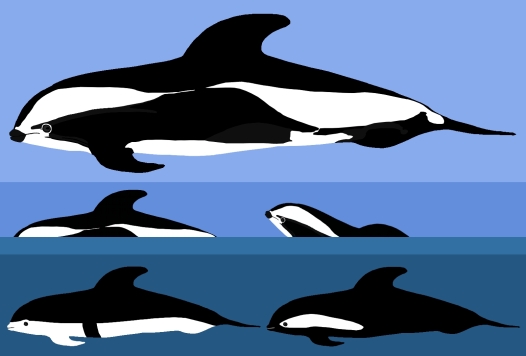
Top: _Lagenorhynchus cruciger_
Middle: _L. cruciger_ in hypothetical crucigère & albigène poses
Bottom: Quoy & Gaimard (1824)’s ‘delphinus cruciger’ & ‘d. albigena’
Quoy & Gaimard (1824) described another new species I haven’t mentioned yet, right before the crucigère and albigène in fact – the so-called Rhinoceros Dolphin. More soon, I swear.
References:
Ellis, R. (1982) Dolphins and Porpoises. Alfred A. Knopf.
Fraser, F. C. (1966) Comments on the Delphinoidea IN: Norris, K. S. Whales, Dolphins, and Porpoises. University of California Press.
Jefferson, T. A. & Karczmarski, L. (2001). Sousa chinensis. Mammalian Species 665, 1-9. Available.
Quoy and Gaimard. (1824). Voyage autour du monde.. l’Oranie et la Physicienne… Zoologie. Available.
True, F. W. (1889) A Review of the Family Delphinidæ. Bulletin of the United States National Museum 36. Available.
Picture of the Day – Survivor
Earlier today, I noticed a small turtle upside-down on the edge of a highway median adjacent to Osamequin Bird Sanctuary. From its small size, the severity of the injury, and the fact it was totally unresponsive, I assumed it was roadkill. It’s always sad to see an animal as slow growing as a turtle dead, and what made this case particularly tragic is that it’s a Spotted Turtle (Clemmys guttata), now considered an endangered species (van Dijk 2011). I had placed the turtle in a box and noticed that every time I walked by, it seemed to be at a slightly different angle. I wasn’t imagining things, it was overcoming shock and beginning to move again. It initially only moved its back legs – making me fear it was paralyzed – but it soon began to use its front legs as well. By then a severe thunderstorm had broken out and not knowing when I’d be able to drop it off and not having access to veterinary manuals or the Internet, I used liquid bandages on the fracture (visible as the dark streak u) to hopefully stop the bleeding, prevent infection, and hold things in one piece as the turtle was becoming more active. The turtle did eventually make its way to a wildlife rehabilitator a few hours later and I hope all goes well.
What surprised me about this specimen is that, having extensively handled a female of the species, is that it was evidently male (thick tail, concave plastron – I couldn’t see the eyes though). Furthermore, is must have been coming from brackish water (as the median was too steep and high to climb) and wasn’t too far from where I found the baby snapping turtle and was in the same body of water in which I recently observed a terrapin. If the specimen recovers, this has me puzzled as to where it should be released, and considering that the species is doing so poorly, perhaps it would be best used in a breeding program.
References:
van Dijk, P.P. 2011. Clemmys guttata. In: IUCN 2012. IUCN Red List of Threatened Species. Version 2012.1. <www.iucnredlist.org>. Downloaded on 26 June 2012.
The Shadow over Portsmouth
In July 2002, Rhode Island had its only second* known fling with marine cryptozoology at Teddy’s Beach in Portsmouth. I was aware of this encounter since 2003 from Bruce Champagne’s “Type 3 Animal Test” but the existence of a newscast came as a total surprise. As with everything ever filmed, it’s on YouTube:
* Edit: I forgot about the “Block Ness Monster”. Thanks, Scott Mardis!
It’s… something. In Narragansett Bay, it makes the news when dolphins travel into the upper reaches, so the possibility of an unknown large, aggressive species cruising around is basically zero. It is tempting to dismiss the encounter at Teddy’s Beach as an inept description of some unknowable mundane species, but what if it’s a surprisingly accurate documentation of a very rare – but known – visitor to the Bay?
Before getting into what the Teddy’s Beach encounter may have been with, I’ll lay out all the available information as objectively as plausible.
Newscast: Sighting occurred on a late Tuesday afternoon, apparently under sunny conditions. Object “roughly” 15 feet long [4.57 meters]. Man “cleaning” wound in the water for an hour and a half nearby [and again two days later?!].
Female eyewitness: Object made hissing sound. Big teeth. Basketball-shaped face, went “in” [eyewitness made tapering gesture], was squared off [made gesture indicating bottom of face], had white coloration [made gesture apparently indicating throat]. Swam around and made physical contact with eyewitness. Contact indicated scales, also suggested to be on the face.
Male eyewitness: Object went “around” eyewitness [spread out arms, unclear meaning] got very close [perhaps 1-2 meters]. Had scales [“a couple” on head?]. Head shaped like a footbasketball [eyewitness made basketball-sized gesture]. Fangs compared to eyewitness’s fingers, gesture indicated 4-5 on bottom plus “two or three” on top plus “layers inside”. Blackish on top [of head]. White under neck. Shot water out of nose. Hissed [while spitting water?] at eyewitness. Object initially thought to be eel. Moved by “rolling” at first [white visible] then moved “like a barracuda” but also with a “hump” when “chasing” female eyewitness [gesture made seemingly indicating vertical and lateral oscillation].
Bruce Champagne: 5 meters in length [contra: 4.57 m]. Greenish-black on top [contra: blackish] white below. Basketball-sized eel-like head [contra: basketball-shaped and sized]. 10 cm long teeth [finger length?]. Investigated swimmer [contra: “chasing”]. Swam with “rolling” motion [contra: “rolling” and “hump”/”barracuda”-like]. Makes mention of body diameter being estimated [inferred from gesture made by male eyewitness?].
My colleague Markus Bühler suggested that perhaps the eyewitnesses encountered a Leatherback Seaturtle (Dermochelys coriacea). Leatherbacks have been documented from Hope Island (Raposa), nearly as far up the Bay as Teddy’s Beach. It came as a major surprise to me that leatherbacks enter Narragansett Bay at all, and I suspect that most other residents are not aware of their occasional presence. What’s especially intriguing about the leatherback hypothesis is that the “layers” of fangs described by the male eyewitness could be explained by keratinized spines:
The “two or three” fangs on the upper jaw could be explained by the projections of the leatherback’s upper beak; there aren’t four or five complimentary projections on the leatherback’s lower beak but perhaps the male eyewitness was counting some of the outlying keratinous projections. Leatherbacks have big round heads, so the comparisons to a basketball plausibly fit. It isn’t clear what going “in” and being squared off could mean on a basketball-shaped head, but perhaps they’re a reference to the wide mouth and the shape of a leatherback’s lower beak. Male leatherbacks have white throats (Ernst and Lovich 2009) which fits the eyewitness descriptions.
The reported antagonistic behavior towards the female eyewitness is… curious. The mention of water coming out of the nose suggests respiratory issues, which means the “hissing” may have been labored breathing. Dermochelys has been reported to vocalize when in duress (Ernst and Lovich 2009) but I’m not clear if hissing is in their repertoire. Chasing a human without prompting would be strange for any animal, so perhaps it was swimming towards the eyewitnesses and the behavior was misinterpreted as aggressive. Leatherbacks will, however, act aggressively towards humans who provoke them:
Leatherbacks may attack boats without provocation. This video is also useful in showing that breathing at the surface can create the illusion of water coming out of the nose:
The initial impression of an eel-like creature would seem remarkable for an observation of a turtle, although the initial part should be stressed along with the male eyewitness’s gesture which may have indicated the object was wide. A length of around 4.57 meters is larger than any leatherback, but there is little reason to take reported sizes literally from any eyewitness. The presence of “scales” is problematic for leatherbacks, which lack them as adults, but it could have been possible that they were misinterpreted bony ossicles and/or mottled coloration. I am admittedly confused what sort of movement the male eyewitness was attempting to describe.
The leatherback hypothesis isn’t a perfect fit, but it’s far more likely an explanation than some bizarre unknown species. The fact that one of the largest living reptiles graces Rhode Island with its presence is fantastic enough as it is.
References:
Ernst, C. H. and Lovich, J. E. (2009) Turtles of the United States and Canada. John Hopkins University Press.
Raposa, K. Aquatic Birds, Marine Mammals, and Sea Turtles IN: An Ecological Profile of the Narragansett Bay National Estuarine Research Reserve. Available.
Picture of the Day – Camel Teeth
My younger and more naïve self was under the impression that camel mouths housed an irregular mess of pegs and spikes, not unlike a certain national stereotype. Camel dentition is more orderly that what brief glimpses into their mouths suggests but, as usual, they’re still really really weird.
First off, is it me, or does this dorsal-ish view of a camel skull make it look weirdly Basilosaurus–like? This is giving me bad ideas for highly unconventional reconstructions. Anyways, this view demonstrates that spatulate incisors are located only on the mandible and that there are well-developed canines. Pronounced canines are not unique among artiodactyls – note the Greater Mouse Deer to the right – but camels are remarkable for having additional canine-like teeth. Lots of them.
After the true canines in both jaws are caniniform first premolars, and before the canines in the upper jaw only are caniniform incisors (Fowler 2011). As for what these teeth are used for, the true canines are most developed in males and apparently adaptations for intraspecific aggression (Fowler 2011). Camels also bite humans – sometimes fatally – and bite marks on extremities leave a distinct “4 dot sign” (Abu-Zidan et al. 2011), which suggests at least one of the other pairs of caniniform teeth can be used to inflict damage.
References:
Abu-Zidan, F. M. et al. (2011) Camel bite injuries in United Arab Emirates: A 6 year prospective study. Injury http://dx.doi.org/10.1016/j.injury.2011.10.039
Fowler, M. E. (2011) Medicine and Surgery of Camelids. Wiley-Blackwell
Picture of the Day – Linnaeus’s Two-Toed Sloth
This Linnaeus’s Two-Toed Sloth (Choloepus didactylus) is kindly demonstrating the suspensory locomotion that extant sloths (Choloepus, Bradypus) typically engage in. Two- and Three-Toed Sloths are distant relatives and since no known fossil sloths were suspensory, this suggests the unusual method of locomotion evolved convergently (Pujos et al. 2012). As for how the 400+ extinct sloths got around, it was much more variable than the “ground sloth” label implies; some burrowed (Scelidotherium, Glossotherium), had some bipedal capability (Megatherium), were tree climbers (some Antillean species), rock climbers (Diabolotherium), and even aquatic and semi-aquatic (Thalassocnus) (Pujos et al. 2012).
References:
Pujos, F., et al. (2012) Recent Advances on Variability, Morpho-Functional Adaptations, Dental Terminology, and Evolution of Sloths. Journal of Mammalian Evolution DOI: 10.1007/s10914-012-9189-y

